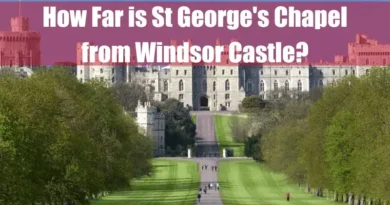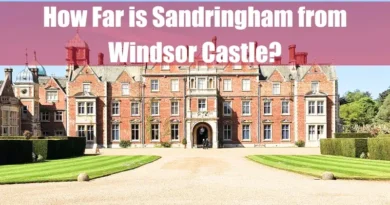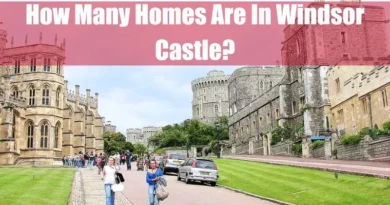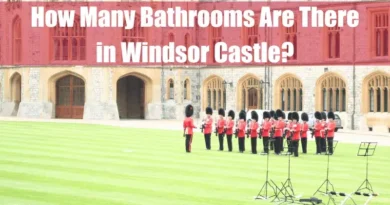The Round Tower, Windsor Castle
Key Takeaways
| Category | Key Takeaways |
|---|---|
| History & Function | – Constructed from durable Kentish ragstone. – Features thick walls (up to 15 feet), crenellated parapets, and machicolations for enhanced defence. – Multi-floor interior for storage, living, and lookout. – Reflects various architectural styles (Gothic, Tudor, Georgian) due to modifications over time. |
| Architecture | – Evidence for some royal use details (e.g., John of Gaunt’s “Queen’s Apartments”) is limited. – Legends (e.g., ghost of King John) are part of the tower’s history but should be distinguished from factual accounts. |
| Significance & Legacy | – A Grade I listed building, ensuring preservation. – A major tourist attraction within Windsor Castle. – A symbol of Windsor’s heritage and the British monarchy’s continuity. |
| Visitor Experience | – Interactive exhibits showcase the tower’s history. – Visitors can climb the winding staircase. – Guided tours provide insights and storytelling. – Educational programs are available for different age groups. |
| Future | – Ongoing maintenance and restoration efforts. – Use of modern technology (3D scanning, digital modelling) for preservation. – Continued research into hidden chambers and other mysteries. |
| Note | – Evidence for some royal use details (e.g., John of Gaunt’s “Queen’s Apartments”) is limited. – Legends (e.g., ghost of King John) are part of the tower’s history, but should be distinguished from factual accounts. |
Introduction
Towering over Windsor Castle’s sprawling complex, the Round Tower stands as a sentinel, a silent witness to centuries of British history. Its imposing form, a sturdy stone cylinder, embodies the castle’s enduring legacy as a royal fortress and residence. For over 800 years, the Round Tower has played many roles—a formidable defensive stronghold and a royal residence.
Its presence evokes a sense of power and grandeur, a tangible reminder of the monarchs who have walked its halls and shaped the nation’s destiny.
Originally constructed in the 1170s by King Henry II, the Round Tower served a crucial purpose – to fortify Windsor Castle against potential invaders. Its circular design, thick walls, and elevated position offered a significant advantage during medieval warfare.
However, as the threat of war receded over the centuries, the Round Tower’s role shifted. Monarchs found its lofty chambers and panoramic views desirable, offering security and a sense of grandeur. The tower’s interior was adapted for royal living, with comfortable apartments.
Today, the Round Tower is a celebrated landmark, welcoming visitors worldwide to explore its rich history and breathtaking views. The “Conquer the Tower” tour offers a chance to climb the top and be rewarded with panoramic vistas of the castle grounds, the Thames Valley, and even the distant skyline of London on a clear day.
The History of the Round Tower

A. A Legacy Built by Henry II
Windsor Castle’s imposing silhouette owes a significant debt to King Henry II (1154-1189). Recognizing the strategic importance of Windsor’s location, just west of London, he embarked on an ambitious project to transform it from a wooden motte-and-bailey fortification into a formidable stone castle. Construction of the Round Tower commenced around 1170, marking the centrepiece of this extensive undertaking.
1. Architectural Innovation for Defensive Prowess:
The Round Tower’s design reflected the prevailing military architecture of the Norman period. It adopted a circular form, a significant departure from the rectangular keeps that were more common earlier. This circular design offered several advantages:
- Superior Defense: Curved walls were less susceptible to damage from siege engines like battering rams, which relied on concentrated force on a single point.
- Eliminating Weak Points: The absence of corners eliminated weak points that could be exploited by attackers attempting to scale the walls or tunnel beneath them.
2. Strength and Durability in Every Detail:
Constructed from a type of local limestone known as Kentish ragstone, renowned for its strength and durability, the Round Tower stood as a formidable obstacle. The walls were incredibly thick, reaching a staggering 15 feet at the base, creating an impenetrable barrier.
3. Defensive Features for a Multi-Layered Approach:
- Crenellated Parapet: At the top of the tower, a crenellated parapet with evenly spaced merlons (the raised sections) and crenels (the gaps) provided a defensive platform for archers and soldiers.
- Machicolations: Openings beneath the parapet, known as machicolations, allowed defenders to drop projectiles and missiles directly onto attackers attempting to scale the walls.
4. The Round Tower as Part of a Cohesive Defense System:
The Round Tower wasn’t solely a standalone structure. It served as the central keep of Windsor Castle, forming an integral part of the overall defensive scheme.
- Curtain Walls and Gateways: A series of curtain walls, fortified with additional towers and gateways, extended outwards from the base of the Round Tower, creating an enclosed courtyard or ward.
- Concentric Defense: This layout created a concentric defence system where attackers would have to breach multiple layers of fortification before reaching the castle’s heart.
- Ultimate Stronghold: The Round Tower, positioned at the highest point within the complex, served as the ultimate stronghold, a place of last resort during a siege.
B. Transformations Through Time

While initially conceived as a purely defensive structure, the Round Tower witnessed numerous transformations over the centuries, reflecting changing needs and architectural styles.
1. Early Modifications (12th & 13th Centuries):
Gateway Addition (King John, 1199-1216): A few decades after its construction, King John made some alterations to the Round Tower. He added a gateway at the base, allowing easier access to the upper floors. This gateway was later blocked up and replaced with a new entrance on a higher level during subsequent renovations.
A central shaft was also constructed within the tower, providing access to the various floors.
While historical records mention King John (1199-1216) authorizing modifications to the Round Tower, specific details about the gateway and central shaft remain unclear. Further research into primary sources like construction accounts or archaeological reports from Windsor Castle might reveal specifics about these alterations.
2. Shifting Roles (14th Century):
As the threat of warfare diminished over time, the Round Tower gradually transitioned from a purely military structure to a more versatile space. Monarchs began to appreciate the tower’s elevated position and spacious chambers, finding them suitable for royal accommodation.
Edward III’s Renovations (1327-1377): In the 14th Century, under the reign of Edward III, the tower’s interior underwent significant modifications to adapt it for royal usage. Windows were enlarged for natural light, and some chambers were decorated with fireplaces and ornate plasterwork. Edward III’s son, John of Gaunt (1340-1399), used the tower as his primary residence.
Sources documenting the everyday lives of medieval royalty can be scarce. There isn’t a definitive consensus on whether Edward III’s son, John of Gaunt (1340-1399), used the Round Tower as his primary residence. However, historical accounts do mention him spending significant time at Windsor Castle. The tower’s spacious chambers and elevated position likely made it a desirable residence within the castle complex.
3. Impact of Historical Events (15th Century):
Wars of the Roses (1455-1485): During the Wars of the Roses, a period of civil war between rival royal houses, Windsor Castle, and consequently the Round Tower, briefly fell under the control of the Yorkist faction. This highlights the tower’s vulnerability during prolonged conflict despite its formidable defences.
However, the castle’s strategic importance remained paramount, particularly due to its proximity to London. The Lancastrians quickly recaptured Windsor, demonstrating the tower’s role as a vital asset in controlling the region and securing a strategic advantage during the conflict. This episode underscores the Round Tower’s dual purpose: as a defensive stronghold and a symbol of power for the reigning monarch.
4. Transformations under the Tudors (16th Century):
Tudor Architectural Trends: The Tudor dynasty (1485-1603) ushered in a new era of architectural trends. While the Round Tower wasn’t significantly altered structurally, it continued to be used as a royal residence, particularly for visiting dignitaries. King Henry VIII (1491-1547) embarked on renovations at Windsor Castle, aiming to create a more palatial residence. The Round Tower, with its strategic location and historical significance, likely remained a prestigious space for guests of the crown.
5. Later Adaptations and Modernization (17th Century – Present):
The English Civil War (1642-1651) saw Parliamentary forces besiege Windsor Castle. While the Round Tower wasn’t directly involved in the conflict, it likely served as a secure storage space for valuables during this period. Following the restoration of the monarchy, the tower’s use primarily shifted towards storage and administrative functions.
In the 19th Century, a renewed interest in medieval history led to efforts to preserve and restore Windsor Castle. The Round Tower benefitted from these endeavours, undergoing renovations that aimed to maintain its structural integrity and historical character.
C. Notable Residents and Captives

1. Kings and queens who used the tower as a residence:
- Edward III (1327-1377): Edward III is confirmed to have played a key role in renovating the Round Tower for royal use. He likely spent time within the more comfortable chambers enjoying the views.
- John of Gaunt (1340-1399): While there isn’t definitive proof that John of Gaunt used the Round Tower as his primary residence, historical records show he spent significant time at Windsor Castle. The tower’s spaciousness and elevated position would have made it a desirable residence within the complex.
- Henry VIII (1491-1547): Specific details about Henry VIII’s use of the Round Tower are unclear. However, it’s plausible he used it occasionally to house visiting dignitaries, offering them a prestigious and secure space.
2. Famous historical figures who were imprisoned within its walls:
- King John of Scotland (1242-1296): Following his capture by English forces in 1296, King John of Scotland was briefly imprisoned within the Round Tower before being transferred to another location. His incarceration served as a symbol of English dominance over Scotland at the time.
- Henry, Duke of Gloucester (1448-1447): A controversial figure in English history, Henry, Duke of Gloucester, was the younger brother of King Henry VI. Accused of treason, he was imprisoned in the Round Tower in 1447 and found dead shortly after that under mysterious circumstances. His death remains a subject of historical debate.
Additional Considerations:
While historical records suggest Charles, Duke of Orléans (1394-1465) might have spent some time imprisoned in the Round Tower during his captivity in England, there’s no definitive confirmation.
3. Accounts and Legends Surrounding Residents:
While historical records provide details about some of the Round Tower’s notable residents, captivating stories and legends have also emerged around their stays. It’s important to distinguish between historical fact and folklore.
a. John of Gaunt and the “Queen’s Apartments”:
There are stories that John of Gaunt had luxurious apartments built within the Round Tower for his wife, Katherine of Lancaster. However, there’s no concrete evidence to support the existence of these so-called “Queen’s Apartments” with elaborate furnishings and a rooftop garden. Historical accounts suggest improvements were made to the tower during his time, but the extent of these modifications remains unclear.
b. The Ghost of King John:
King John of Scotland’s brief imprisonment in the Round Tower has inspired a persistent legend. Stories claim his restless spirit haunts the tower, wandering the halls and lamenting his capture. These tales likely stem from the dramatic nature of his imprisonment. Reports of unexplained sounds and sightings should be viewed as folklore rather than factual occurrences.
Architectural Marvel: Exploring the Design and Features of the Round Tower

The Round Tower of Windsor Castle is a powerful testament to military ingenuity and evolving architectural styles. From its formidable exterior to its surprisingly comfortable interior, the tower embodies a rich history of defence, adaptation, and royal grandeur. Let’s delve into the details that make this structure such a captivating landmark.
A. A Fortified Form
1. The Power of the Circle:
Unlike many medieval keeps, which adopted a rectangular form, the Round Tower embraces a circular design. This seemingly simple choice offered significant advantages in warfare:
- Superior Defense Against Siege Engines: Battering rams, a common weapon used to breach castle walls, relied on concentrated force on a single point. The curved walls of the Round Tower deflected the impact, dispersing the force and making it more difficult to inflict significant damage.
- Eliminating Weak Points: Rectangular structures have corners, creating natural vulnerability points for attackers to exploit. A circular design eliminates these corners, offering a more continuous and robust defensive line.
2. A Tower of Strength:
Material and construction techniques further emphasized the tower’s defensive capabilities:
- Local Limestone: Constructed from Kentish ragstone, a local limestone renowned for its strength and durability, the Round Tower boasts walls that reach a staggering 15 feet thick at the base. This immense thickness created a formidable barrier that would have been incredibly difficult to breach.
- Crenellated Parapet: The top of the tower is crowned with a crenellated parapet featuring alternating merlons (raised sections) and crenels (gaps). This design provided a defensive platform for archers and soldiers to fire upon attackers attempting to scale the walls. Additionally, the gaps allowed defenders to drop projectiles like stones or boiling oil directly onto attackers below.
- Machicolations: The parapet incorporates machicolations, openings that project outwards from the wall. These openings allow defenders to drop projectiles and missiles directly down onto attackers attempting to climb the walls, offering an additional layer of defence.
3. A Fortified Complex: The Round Tower Within the Castle Walls
The Round Tower wasn’t solely a standalone structure. It served as the central keep, forming the heart of a comprehensive defensive system:
- Curtain Walls and Gateways: A series of curtain walls fortified with additional towers and gateways extended outwards from the base of the Round Tower. These walls enclosed an inner courtyard or ward, creating a layered defence.
- Concentric Defense: This layout created a concentric defence system. Attackers would have to breach multiple layers of fortification, including the curtain walls, outer towers, and finally, the formidable Round Tower itself. This system offered significant time for the castle defenders to mount a counter-attack.
B. Unveiling the Inner Workings

While the exterior boasts a stark and imposing presence, the Round Tower’s interior reveals a more practical and surprisingly well-equipped space.
1. Accessing the Upper Floors:
A central shaft within the tower’s thick walls provides access to the various floors. This central shaft likely housed a spiral staircase, although modern renovations have included a new staircase for improved visitor accessibility.
2. A Layered Living Space:
The Round Tower is divided into several floors, each serving a specific purpose. While the exact layout may have changed slightly over time, historical records suggest the following:
- Lower Floors: The lower floors likely served as storage spaces for provisions, weaponry, and other essential supplies. These floors may also house kitchens and other useful spaces.
- Upper Floors: The upper floors offered more comfortable living quarters. Larger chambers were likely used for sleeping and entertaining, while smaller rooms may have served as private offices or studies.
- Top Floor: The top floor, directly beneath the crenellated parapet, may have been used as a lookout point and offered breathtaking panoramic views of the surrounding landscape.
3. Adapting to Royal Needs:
As the Round Tower transitioned from a purely military structure to a royal residence, modifications were made to enhance its livability. Windows were enlarged to allow for more natural light, and some chambers were likely decorated with fireplaces and ornate plasterwork to create a more comfortable environment.
C. Symbols of Power and Status

While the Round Tower retains its essential defensive character, subtle touches hint at its past role as a royal residence:
1. Royal Insignia:
While the exterior may have displayed royal heraldry in the past, verifiable evidence is limited. A possibility is that some remnants of insignia, such as coats of arms or monograms, might be found carved into stonework or incorporated within decorative details.
2. Presence of Grand Halls or Ornately Decorated Chambers:
Historical accounts, particularly those surrounding Edward III’s renovations, suggest the presence of grander spaces within the Round Tower. These chambers may have been adorned with:
- Fireplaces: Large fireplaces would have provided warmth and a focal point for gatherings in the colder months.
- Ornate Plasterwork: Decorative plasterwork on ceilings or walls could have featured intricate designs, geometric patterns, or even heraldic motifs.
- Tapestries and Rich Furnishings: Luxury tapestries depicting historical scenes, heraldic emblems, or hunting scenes may have adorned the walls, while richly upholstered furniture would have added comfort and opulence.
It’s important to note that while historical records mention these grander features, concrete evidence is limited. Over time, much of the tower’s interior was likely adapted for more practical uses, and extensive renovations may have obscured some of the earlier decorative elements.
3. Architectural Features Reflecting Changing Styles:
As mentioned earlier, the Round Tower witnessed numerous transformations throughout history. These changes are subtly reflected in the architectural details:
- Medieval Simplicity: The core structure, with its thick walls, narrow windows, and emphasis on functionality, retains a distinctly medieval character.
- Gothic Touches: Edward III’s renovations in the 14th Century likely incorporated some Gothic elements, such as the enlargement of windows and the potential use of pointed arches in doorways or fireplaces.
- Later Modifications: While less prominent, later alterations may have included elements reflecting Tudor or Georgian architectural styles. These could be subtle details like changes in window frames, doorways, or even decorative plasterwork motifs.
The Round Tower’s architectural narrative presents a variety of styles. Instead, it showcases a fascinating layering of features, each reflecting the changing needs and tastes of the times.
The Round Tower and the Monarchy
The Round Tower’s transformation from a military stronghold to a space fit for royalty unfolded gradually. Early modifications under Edward III in the 14th century aimed to create more comfortable living quarters. Historical accounts suggest improvements were made, such as enlarging windows for better light.
Monarchs like Edward III and John of Gaunt likely spent time within the tower, enjoying the panoramic views and spacious chambers. While the Round Tower never became a primary residence for any monarch, it served as a prestigious and secure space, particularly for hosting visiting dignitaries. Even Henry VIII, known for his grand palaces, likely utilized the tower for guests.
Throughout its existence, the Round Tower has borne silent witness to pivotal moments in British history. During wartime, the tower’s formidable defences would have played a crucial role in safeguarding the monarchy and its valuables. While not directly involved in major battles itself, the tower likely served as a secure storage space during conflicts like the English Civil War.
Beyond warfare, the tower has been a silent observer of coronations, political upheavals, and the changing of the guard. Its enduring presence embodies the continuity of the British monarchy, standing as a tangible link between past and present. The Round Tower is more than just a historical landmark; it’s a potent symbol of the monarchy’s long and storied legacy.
Echoes of the Past: Legends and Lore of the Round Tower
The Round Tower’s imposing presence and rich history have inevitably created a captivating collection of myths and legends. One enduring tale surrounds King John of Scotland, who was briefly imprisoned within the tower following his capture in 1296. Stories depict him as a restless spirit, forever lamenting his captivity and wandering the halls with mournful sighs. Visitors and staff alike have reported unexplained sounds and shadowy figures, particularly during twilight hours, fueling the legend’s fire.
Another story, perhaps fueled by a desire for royal grandeur, centres on John of Gaunt’s wife, Katherine of Lancaster. Legend suggests he commissioned luxurious “Queen’s Apartments” within the tower, adorned with rich furnishings and a private rooftop garden. However, concrete evidence for these elaborate additions still needs to be discovered. Whether rooted in fact or fueled by imagination, these stories add a layer of intrigue to the Round Tower’s narrative, captivating visitors and perpetuating its mystique.
The Round Tower’s history continues to be unravelled through ongoing research and occasional discoveries. Recent studies have focused on the possibility of hidden chambers or passageways within the tower’s thick walls. These hidden spaces could offer clues to the tower’s past uses or even lend credence to legends surrounding figures like King John. Workers have uncovered remnants of earlier architectural features during renovations, hinting at the tower’s evolution.
Unanswered questions linger; for instance, the exact layout of the interior chambers, particularly in the early centuries, still needs to be determined. As discoveries are made and historical records are re-examined, our understanding of the Round Tower’s secrets continues to evolve, ensuring its enduring fascination for future generations.
The Round Tower Today: A Legacy Unveiled

The Round Tower of Windsor Castle isn’t just a relic of the past; it’s a vibrant landmark that continues to captivate visitors with its rich history and architectural marvels. Let’s explore how this enduring symbol of power is preserved, presented, and poised for the future.
A. A Standing Symbol: A Beacon of History and Tourism
- Preserved for Posterity: The Round Tower is protected as a Grade I listed building in the UK. This designation ensures rigorous maintenance and adherence to strict preservation guidelines, guaranteeing its survival for future generations.
- A Jewel in the Crown of Windsor Castle: Integrated into the larger Windsor Castle complex, the Round Tower draws many tourists each year. Revenue generated from ticket sales contributes to ongoing upkeep and restoration efforts.
- A Beacon of Local Identity: The Round Tower transcends its role as a historical landmark. It is a source of local pride and a symbol of Windsor’s rich heritage. The tower’s presence is often incorporated into local events and festivals, further solidifying its connection to the community.
B. A Glimpse into a Bygone Era: Engaging the Visitor’s Imagination
1. Interactive Exhibits:
Stepping inside the Round Tower isn’t just a visual experience; it’s a journey through time. Engaging exhibits showcase the tower’s evolution, from its initial defensive role to its days as a royal residence. Visitors can likely explore informative displays that bring history to life.
2. A Climb Through History:
While some modifications have been made for accessibility, the core experience of ascending the Round Tower remains evocative. Visitors can climb the winding staircase, imagining the footsteps of monarchs and soldiers who traversed the same path centuries ago.
3. Guided Tours with a Human Touch:
Knowledgeable guides bring the tower’s history alive through captivating storytelling and insights. Visitors can delve deeper into specific aspects of the tower’s past, from architectural details to fascinating legends surrounding its royal residents.
4. Educational Programs for All Ages:
The Round Tower strives to engage a wide audience. Educational programs designed for different age groups may be offered, allowing students to connect with history in a fun and interactive way. These programs could potentially include activities like historical reenactments, costume demonstrations, or workshops exploring topics such as medieval weaponry or siege warfare.
C. The Round Tower’s Future: Safeguarding a Legacy
Ongoing Maintenance and Restoration: Regular inspections and maintenance are crucial for preserving the Round Tower’s structural integrity. Restoration efforts, conducted by skilled artisans using traditional techniques, ensure the tower’s architectural details and historical character are maintained for future generations.
Modern technology plays a vital role in safeguarding the Round Tower’s legacy. Techniques like 3D scanning and digital modelling can be instrumental in historical preservation. These methods create detailed records of the tower’s structure, potentially aiding in future restoration efforts and providing valuable data for ongoing research.
As historical records are re-examined and new technologies emerge, researchers continue to explore the Round Tower’s secrets. The possibility of hidden chambers or passageways within the walls remains a subject of ongoing investigation, potentially offering new insights into the tower’s past functions and uses.
The Round Tower stands as a testament to the enduring power of history. Through ongoing preservation efforts, innovative visitor experiences, and a commitment to unlocking its remaining mysteries, the Round Tower is poised to continue captivating audiences for centuries.
Conclusion
The Round Tower of Windsor Castle transcends its physical form. It’s a captivating tapestry woven from threads of military might, architectural ingenuity, and the ever-evolving story of the British monarchy. From its formidable defences to its surprisingly comfortable living quarters, the tower embodies a rich history of adaptation and resilience. Standing tall today, the Round Tower serves not just as a preserved landmark but as a vibrant educational resource, offering visitors a chance to connect with the past and gain a deeper appreciation for the enduring legacy it represents. As research continues to unearth new details and captivating stories unfold within its walls, the Round Tower promises to enthral audiences for future generations.










Comments are closed.